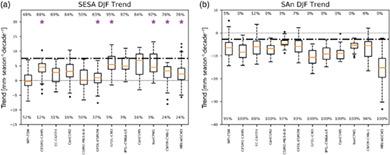当前位置:
X-MOL 学术
›
Int. J. Climatol.
›
论文详情
Our official English website, www.x-mol.net, welcomes your
feedback! (Note: you will need to create a separate account there.)
Assessment of South America summer rainfall climatology and trends in a set of global climate models large ensembles
International Journal of Climatology ( IF 3.5 ) Pub Date : 2020-05-09 , DOI: 10.1002/joc.6643 Leandro B. Díaz 1, 2, 3 , Ramiro I. Saurral 1, 2, 3 , Carolina S. Vera 1, 2, 3
International Journal of Climatology ( IF 3.5 ) Pub Date : 2020-05-09 , DOI: 10.1002/joc.6643 Leandro B. Díaz 1, 2, 3 , Ramiro I. Saurral 1, 2, 3 , Carolina S. Vera 1, 2, 3
Affiliation

|
The purpose of this study is to assess the ability of a set of large ensembles (LE) of Global Climate Model (GCM) simulations from the Multi‐Model Large Ensemble Archive, Coupled Model Intercomparison Project Phase 6 (CMIP6) and database for Policy Decision making for Future climate change in reproducing the variability and change of the austral summer precipitation observed in South America along the second part of the 20th century and beginning of the 21st. LE show similar biases in the mean austral summer rainfall and interannual variability than those detected in previous model sets, such as the Coupled Model Intercomparison Project Phase 5 (CMIP5). The positive trends in south‐eastern South America (SESA) and negative ones in the southern Andes (SAn), that are the most significant observed regional features, are identified to some extent in LE simulations. The negative trend in SAn is a feature consistently shown among different models. For all models, mean trend is negative in that particular region and larger than the inter‐member dispersion for each large ensemble. Trend magnitudes in the SESA region show a larger dispersion between models than the SAn region. While the mean trend among models is consistent with the observations, models underestimate the observed trend. The multi‐model ensemble of selected models that best reproduce both mean and interannual variability features of rainfall in South America shows an 18% larger positive mean trend in SESA rainfall than those that have the worst performance. However, internal variability uncertainty is still higher than the mean trend for both sets of multi‐model ensembles [5% (18%) for selected (non‐selected) models]. Improvements in the representation of the main features of mean rainfall and variability are needed in order to better describe and reduce the uncertainties associated with the main climate change related signals in the continent.
中文翻译:

大型集合体在一组全球气候模型中评估南美夏季降雨气候和趋势
这项研究的目的是评估来自多模型大型集合档案,耦合模型比较项目第6阶段(CMIP6)和政策决策数据库的一组大型整体气候模型(GCM)模拟的能力再现未来气候变化,再现20世纪下半叶和21世纪初在南美观测到的夏季南半球降水的变化和变化。LE在夏季平均南半球降雨和年际变化方面显示出与先前模型集(例如,耦合模型比较项目第5阶段(CMIP5))中发现的相似的偏差。南美东南部(SESA)的积极趋势和安第斯山脉南部(SAn)的消极趋势是最明显的区域特征,在LE仿真中得到了一定程度的识别。SAn的负趋势是在不同模型之间始终如一的特征。对于所有模型,平均趋势在该特定区域均为负,并且大于每个大型集合的成员间离散。与SAn区域相比,SESA区域中的趋势量显示模型之间的分散程度更大。尽管模型之间的平均趋势与观察结果一致,但模型低估了观察到的趋势。所选模型的多模型集合能最好地重现南美洲降雨的均值和年际变化特征,显示SESA降雨的正平均趋势比性能最差的正趋势大18%。然而,内部变异性不确定性仍高于两组多模型合奏的平均趋势[选定(未选定)模型的5%(18%)]。为了更好地描述和减少与该大陆主要与气候变化有关的信号相关的不确定性,需要改进平均降雨量和变化率的主要特征的表示法。
更新日期:2020-05-09
中文翻译:

大型集合体在一组全球气候模型中评估南美夏季降雨气候和趋势
这项研究的目的是评估来自多模型大型集合档案,耦合模型比较项目第6阶段(CMIP6)和政策决策数据库的一组大型整体气候模型(GCM)模拟的能力再现未来气候变化,再现20世纪下半叶和21世纪初在南美观测到的夏季南半球降水的变化和变化。LE在夏季平均南半球降雨和年际变化方面显示出与先前模型集(例如,耦合模型比较项目第5阶段(CMIP5))中发现的相似的偏差。南美东南部(SESA)的积极趋势和安第斯山脉南部(SAn)的消极趋势是最明显的区域特征,在LE仿真中得到了一定程度的识别。SAn的负趋势是在不同模型之间始终如一的特征。对于所有模型,平均趋势在该特定区域均为负,并且大于每个大型集合的成员间离散。与SAn区域相比,SESA区域中的趋势量显示模型之间的分散程度更大。尽管模型之间的平均趋势与观察结果一致,但模型低估了观察到的趋势。所选模型的多模型集合能最好地重现南美洲降雨的均值和年际变化特征,显示SESA降雨的正平均趋势比性能最差的正趋势大18%。然而,内部变异性不确定性仍高于两组多模型合奏的平均趋势[选定(未选定)模型的5%(18%)]。为了更好地描述和减少与该大陆主要与气候变化有关的信号相关的不确定性,需要改进平均降雨量和变化率的主要特征的表示法。











































 京公网安备 11010802027423号
京公网安备 11010802027423号